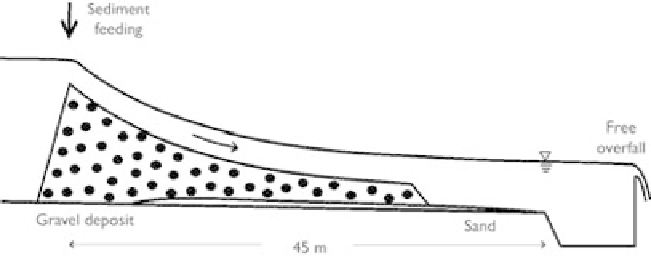Geoscience Reference
In-Depth Information
depth. The time to reach equilibrium increases as the mixing layer thickness increases.
The choice of the mixing layer thickness is particularly important in the case of bed
scour and armoring.
Case 2. Channel aggradation
The channel aggradation experiments performed by Seal
et al
. (1995) were calculated.
The experimental setup is shown in Fig. 5.20. The flume was 45 m long and 0.305 m
wide, with an initial bed slope of 0.002. The tailgate was kept at a constant height,
so that an undular hydraulic jump was produced at the downstream end of the main
gravel deposit. The input sediment was a weakly bimodal mixture comprising a wide
range of sizes, from 0.125 to 64 mm. Due to sediment overloading, an aggradational
wedge developed and its front gradually moved downstream while the upstream bed
elevation continued to rise. In simulated experimental run 2, the water discharge was
0.049 m
3
s
−
1
, the sediment feed rate was 5.65 kg
min
−
1
, and the tailgate water stage
·
was 0.45 m.
Figure 5.20
Sketch of channel aggradation experiments of Seal
et al
. (1995).
The model sensitivity to the adaptation length
L
t
was analyzed by specifying
L
t
as
0.5 m, 2 m, and 7.3
h
while setting the mixing layer thickness as half the dune height.
Here,
h
is the average flow depth over the wedge from the inlet to the gravel deposit
front, and 7.3
h
is approximately equal to 1 m. Fig. 5.21 compares the measured and
predicted bed profiles at various times, and the water surface profiles at the final
stage. The bed profiles were reproduced well, and the hydraulic jump downstream
of the gravel deposit front was predicted qualitatively. It is shown that
L
t
has little
influence on the height and celerity of the gravel deposit front, as well as the top slope
of the wedge. The only significant impact is on the slope of the deposit front. The
longer the adaptation length, the gentler the front slope.
Fig. 5.22 shows the calculated bed profiles when the mixing layer thickness was
given as
d
50
,6
d
50
, and half the dune height and the adaptation length was kept at
0.5 m. The differences between the calculated bed profiles are very small. As the mixing
layer thickness increases six times, the deposit front moves downstream by only 1.3%.
The model is much less sensitive to the mixing layer thickness in the deposition case
than in the previous erosion case.

